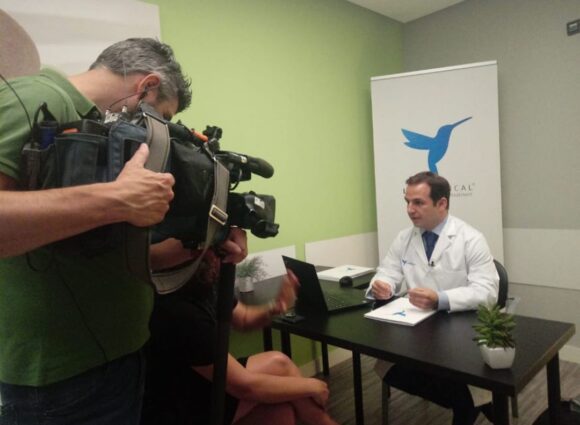What is lipedema?
Lipedema is a progressive disease of the fatty tissue that affects almost exclusively women and that is characterized by a pathological accumulation of fat predominantly in inferior or superior extremities. It´s quite common to ask what is lipedema, as it is a very unknow disease in Spain and the rest of the world. In 2019 it has been recognized by the WHO (World Health Organization). In english and spanish we use the word lipedema, but in some european countries it is known as lipoedema, lipodem o lipöedema.
Recently, the doctor Burgos de la Obra appeared in the spanish national diary 20 minutes explaining what is lipedema, being recognized as an expert with this disease in Spain. Also, doctor Burgos has appeared in the national news of Antena 3, being the first time lipedema it has been recognized as a disease in Spain.

What is its origin?
The origin of this medical entity is not clear, it has been proven that there is a genetic component, as well as a hormonal component, since it often begins or intensifies coinciding with a change in hormones levels (puberty, pregnancy, menopause, contraconceptive pill…).
Does it respond to exercise or diet?
Characteristically, adipose cells affected by lipodema have a very limited response to diets and physical exercise, even if it is intense; patient practically “lives on a diet” and has performed numerous types of physical exercise with minimal response in volume loss, which leads to a frequent sense of frustration and despair.
What is its evolution?
Pathological adipose cells of legs and arms progressively increase in size, therefore the female body develops a specific fat distribution. The main characteristic of lipedema is disproportion between legs or arms (with great accumulation of fat) and the rest of the body. Little by little, this increase in adipose cells volume, due to deposition of fat, leads to an increase in the pressure in the tissues, favouring the appearance of the most important symptom of lipedema: pain.
Pain in the initial stages can be very subtle, although it increases with the progression of the disease. This pain in legs or arms may be present at rest and may increase when walking. In fact, it often worsens with exercise. It is very frequent, in addition, to present tenderness/pain to palpation (especially in certain places like the inner face of the calves), and to experience a continuous sensation of legs heaviness. Due to capillary fragility in patients with lipedema, it is common to find a tendency to bruising if affected areas, in many cases without the patient remembering having suffered a trauma in that area.
Is it a frequent disease?
This medical condition can be present in up to 5% of women; however, it is not yet globally known by the medical community despite having been approved in May 2018 by WHO as a disease in the International Classification of Diseases-ICD-11. You can check this classification here.
How is it diagnosed?
The diagnosis of lipedema is mainly clinical, therefore, a consultation with a lipedema specialist is necessary to carry out a detailed anamnesis and a specific physical examination to confirm the pathology. In case of doubt, it may be necessary to perform additional tests to rule out other sources of symptoms. Find out more about the symptoms and diagnosis of lipedema here.
How lipedema is it treated? Does it has a solution?
Why evaluate your case with Lipemedical – Dr. Burgos de la Obra Team?
Dr. Burgos de la Obra was the first Spanish surgeon to use the WAL technique for lipedema and is one of the european pioneers in superespecialized treatment of lipedema and actually one of the main specialized Lipedema doctor. In lipedema treatment, experience and specialization are absolutely crucial to obtain the optimal result for each case with the lowest risk of complications.
Dr. Burgos’s approach to lipedema is clear:
“This disease must be approached as a medical problem and not as a purely aesthetic condition. Lipedema can and must be effectively treated to free the patient from the symptoms and prevent progression. It is a duty of the medical community to know about this clinical entity and help spread information about its diagnostic criteria and treatment to avoid patients suffering the lack of knowledge of their own disease and its incorrect diagnosis.”
Is Lipedema covered by the Spanish national Social Security?
Currently although lipedema is recognized as a disease, is not covered by the Spanish National Social Security
What do I do if my doctor doesn´t know about lipedema?
In Lipemedical we believe that it is essential that this disease is known as soon as possible by the entire medical community since early diagnosis and treatment can greatly stop the progression and avoid years of frustration for patients. You can provide your doctor with the following scientific documents to share with him that lipedema is a real disease and that requires treatment:
- German guidelines for lipedema treatment
- English guidelines for management of lipedema
- Dutch guidelines lipedema
- Spanish medical societies consensus document about lipedema
- WHO International Classification of Diseases (ICD11) – lipoedema code
- Scientific articles about lipedema in prestigious international journals:
With all this international scientific evidence it is undeniable that lipedema is a real medical condition, frequently underdiagnosed and that it requires the maximum attention of the medical community, we encourage you to contribute to its knowledge by sharing this documents.

